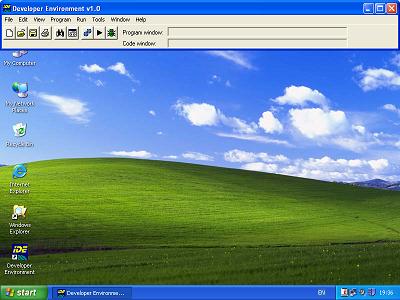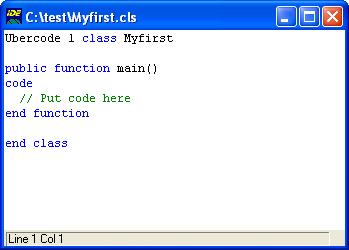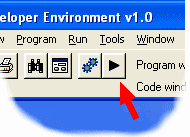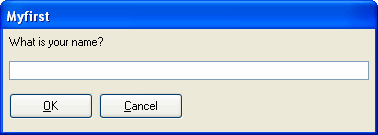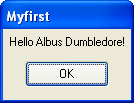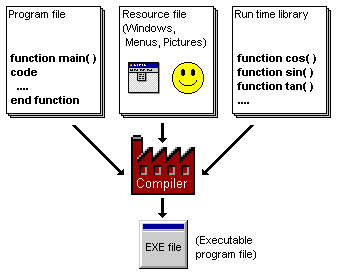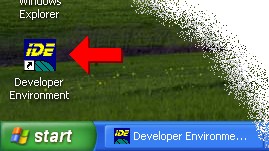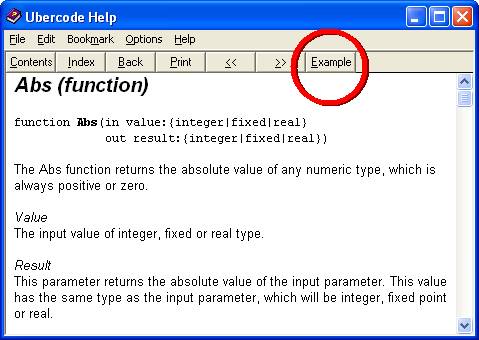Start To Program Now!
| Home page |
| What is Uberbot |
| What is Ubercode |
| Free trial |
| Ubercode store |
| Testimonials |
| Tech support |
| Forum |
| Links |
| News blog |
1. How do I write a starter program?The simplest possible starting program is the Hello World program. This asks you to type in your name, then prints out a short greeting:
// Myfirst.cls
Ubercode 1 Class Myfirst
public function main()
var
MyName:string[*]
code
MyName <- Inputbox("Myfirst", "What is your name?")
call Msgbox("Myfirst", "Hello "+MyName+"!", "OK")
end function
end class
The following steps show how to run the program. They assume you've installed Ubercode - if not download the free Trial Package then continue. (i) Start the Developer EnvironmentStart the Developer Environment from Windows, using Start - Programs - Ubercode - Developer Environment or by double clicking the Ubercode icon on the desktop. When it starts, you will be shown the Startup Wizard screen. In the Startup Wizard, click the Close button because we don't need the wizard at this time. After the wizard has gone, your desktop should look like this:
The top part of the screen is occupied by the main menu. (ii) Write the ProgramIn the Developer Environment, use the File - New - Program menu command to write the code. A dialog titled "New Program" will appear. Click in the entry field next to "Name" and type in "Myfirst" (without the quotes). Then click in the entry field next to "Program Type", delete the existing text and and type in "2" (again without the quotes). Click OK to create the new program which looks like this:
The name you typed in (Myfirst) was used as the class name and the file name. It's not essential the name was "Myfirst", you could have typed any other alphabetic name. The choice of "2" (Program type = Main function) means the new program uses a function (block of code) instead of a window. Now change the program to use an Inputbox to prompt for the name and a Msgbox to display the result. Change the following code:
public function main()
code
// Put code here
end function
into this:
public function main()
var
MyName:string[*]
code
MyName <- Inputbox("Myfirst", "What is your name?")
call Msgbox("Myfirst", "Hello "+MyName+"!", "OK")
end function
The changes are to declare a string variable MyName, and to add the calls to Inputbox and Msgbox. When changing the code, make sure the commas and double-quotes match those above. (iii) Run the programNow it's time to compile the program and run it. Click the Run button and wait a few moments:
The program is saved automatically when the compiler starts. After it compiles, the program starts running as a Windows EXE file. You should then see the Inputbox appear:
Type some text in the Inputbox and click OK. You should then see the Msgbox:
The text that came from the Inputbox forms part of the greeting in the Msgbox. If you look at the call to Msgbox in the code, you'll see there are two string parameters. The first string "Myfirst" is put in the message box caption (the blue area) and the second string (the greeting message) is in the main part of the message box. This order is easy to remember because it flows down the page. Finally, click OK to close the program. 2. How does Ubercode work?Start by writing a program, which is a list of commands to be processed by the computer. A typical beginner's program has 20 or 30 lines of commands. Then design the forms (windows) used by the program. After writing the program you compile it. The compiler checks the code for errors and if OK it makes an EXE file. Then you run the EXE file which carries out the commands in the program. Here's a diagram:
The diagram shows how the compiler converts the program, the resource file(s) and the run time library into an EXE file. The run time library contains many powerful commands ready for use in your programs. This is code you don't have to write. The steps shown above are automated using the Developer Environment, which is a "control centre" for writing programs. The EXE file shown near the bottom is a very important file. This contains all of your program in a condensed (binary) form, and can be run independently of the Developer Environment, or copied to other computers (licence permitting). 3. What help is available when writing a program?Different levels of help are available, depending on whether you want help with a specific command, or whether you want help writing a particular type of program.
4. Where can I find more starter programs?Example programs are available from the following places:
5. How do I run an example program?
|
